Zpacks Duplex Overview
There is so much to consider when choosing a backcountry shelter. Is it big enough? Will it protect me from rain and bugs? And if the answer is yes to both, does that mean it’s heavy and hard to pack? Zpacks has been asking and answering these questions better than anyone since 2005, and the Duplex tent is the pinnacle of their accumulated wisdom.
This tent is so ridiculously cool. Breathtakingly lightweight, surprisingly roomy, and cleverly weather resistant — the Zpacks Duplex is our slam dunk Premium Pick tent for the Ultralight Backpacker.
Zpacks Duplex Star Rating
- Sleep Comfort
- Durability
- Ease of Setup
- Space
- Vibe
Summary
The Zpacks Duplex is an ultralight tent made of DFC, a waterproof and incredibly durable material. It requires trekking poles (or separately purchased poles) to setup, but weighs a scant one pound, five ounces. The amount of room is surprisingly large, and it comes with noseeum mesh and a bathtub floor.
While there are technically lighter shelters, they are more like tarps and less like tents. We believe the merits of a tent — a floor, mesh walls, a vestibule, and enough room to stretch a little — are worth a lot in the wild. There are other tents that come close, notably the Hyperlite Mountain Gear UltaMid 2 Pyramid Tent, but we also prefer it when the tent pole (or trekking pole) is outside the tent. If that’s not how you feel, definitely check out the UltaMid.
See the full Zpacks Duplex review below.
Zpacks Duplex Specifications
| Feature Type | Feature Specs | What This Means |
| Packed Weight | 21 oz. (595 g) | This is as light as a full 2P tent can get. Weight does not include stakes or poles (the tent is set up with trekking poles), but even with those added, you’re looking at roughly two pounds. Crazy light. |
| Type | Tarp Tent/Semi-Freestanding | In its basic setup, the Duplex requires two trekking poles and staked out corners for tension, making it a tarp tent. It won’t stand up by itself at all. You can purchase poles from Zpacks that make it freestanding, though staking it out is always necessary. |
| Wall Type | Single Wall Hybrid | The Duplex is a single wall tent, in that there is no separate rain fly and mesh tent body. They are stitched together, so the ceiling is the rainfly, while the mesh protects the sides. It’s a hybrid because it also has vestibules that are separate from the mesh. |
| No. of Doors | 2 | Two fully zippered doors on either end of the tent. Great for couples or a pair who wants their own entry and exit. |
| Sleeping Capacity | 2-person | The Duplex is a two-person tent, though a tight two person. In the ultralight world it has oodles of space, and will fit two 20″ pads side by side, but if you’re not used to cramped quarters this will feel small. |
| Seasons | 3-Season | You can take this tent in almost all conditions, but the mesh interior means it doesn’t have much wind-stopping protection. That said the fabric (Dyneema Composite Fabric) is durable, waterproof, and highly wind resistant. Billed as a 3-season tent. |
| Packed Size | 12 in. x 7 in. (30 cm x 18 cm) | You could get it smaller, but this is the the standard size after re-packing the tent. It’s very small, about the size of a small sleeping bag or even smaller. |
| Floor Dimensions | 90 in. x 45 in. (230 cm x 114 cm) | This is a surprising amount of space for such a light tent. You can fit most oversized people in here (length is 7.5 feet), and two 20-inch pads side by side. Luxury for ultralight. |
| Floor Area | 28.1 square feet | Lots of area to lay out, and extra room at your feet for gear. |
| Peak Height | 48 in. (122 cm) | A standard peak height for tents. You can sit up easily in the center. It does slope pretty solidly, so you can’t sit up fully on either end. |
| No. of Vestibules | 2 | Two full vestibules means plenty of storage for gear, shoes, and even a space to cook if you’re in inclement weather. |
| Vestibule Area | 20.75 in. depth on each side (53 cm) | The vestibules on the Duplex are quite large. |
| No. of Poles | 0 | The Duplex does not come with poles, you use your own trekking poles to set it up. You can buy Straight Poles if you want, or a Freestanding Upgrade. If you do either of these you would have two poles. |
| Pole Material | Carbon Fiber | If you buy Straight Poles from Zpacks, they are carbon fiber. If you buy the Freestanding Upgrade, they are Easton Carbon Ion poles, which are very fancy and have a lot of stretch and strength. |
| No. of Interior Pockets | 2 mesh pockets | Two small pockets hang on either end of the tent. Small, but good for storing flashlight, headlamp, etc. No pockets above. |
| Body Fly Material | Dyneema Composite Fabric (DFC), .51 oz/sqyd | DFC is space-age-esque fabric that does not rip easily, is 100% waterproof, and doesn’t stretch. All while being very, very light. The whole tent is made out of this fabric, except for the mesh. |
| Floor Material | Dyneema Composite Fabric 1 oz/sqyd | The floor is also DFC, but is thicker than the rest of the tent for increased durability. |
| Mesh Material | .7 oz/sqyd insect screen. | Ultralight mesh that Zpacks claims is 30% lighter than Noseeum (the industry standard), while retaining durability and bug-proof-ness. |
| Rainfly, Fast Setup? | N/A | This tent doesn’t have a separate rain fly. It all sets up in one piece. |
| Manufacturer Warranty | 1-Year Warranty | Zpacks offers a one year warranty against defects in materials or workmanship. This is far from the industry standard, which is a lifetime warranty against these issues. Zpacks is a small company, its products are very durable, and it has excellent customer service. It also says it will provide basic repairs at no cost for the reasonable lifespan of your gear. If you notice an issue with your tent, be sure to get in touch immediately. |
| Retail Price | $599 | Basically the most you would want to spend on an ultralight tent. This is a premium product due to materials and design, and your wallet will feel it. |
Gear Review of the Zpacks Duplex
Origins: Easing You In
If you’ve read any of my other gear reviews you know I’m a lightweight junkie. Ever since reading Ray Jardine’s classic Beyond Backpacking in college, I have been dangerously obsessed with cutting my pack weight one tenacious ounce at a time.
With that said, shelter options have always proved to be my nemesis. Bivy sacks sound great, until you realize they won’t really keep you dry if it pours. Tarps carry a certain old school cool factor, but after getting eaten alive by mosquitoes and drenched in a thunderstorm at the base of Forester Pass I decided they are old school for a reason. Of course you can buy a premium tent from one of the top name-brand manufacturers, but even those aren’t impressively light.
Every time I tried something, I just came back more annoyed that the perfect tent didn’t exist. And then I found Zpacks, and angels began singing as sunbeams shone through the clouds. Game changer.
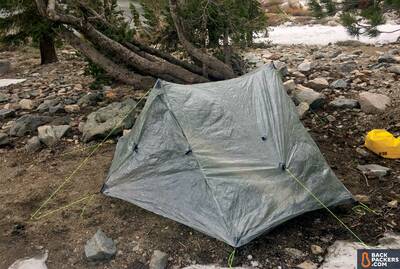
The Zpacks Duplex is a game changer in the ultralight backpacking world.
Revelation: The Moment I Knew
My first Zpacks tent was the Hexamid Solo, and I used it on a John Muir Trail fastpacking trip. I absolutely, unabashedly love that tent. And I have to say, I love the Duplex even more.
As I stuffed the Duplex into my pack I was pleasantly surprised at how small and light it was, given that it claims to be big enough for two people. So small in fact that I was able to fit it into my pack, rather than have to strap it to the outside like you would with a traditional tent.
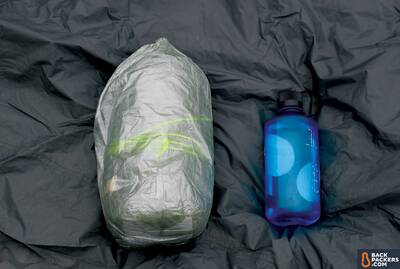
The Zpacks Duplex next to a standard 32 ounce Nalgene. Yes, it’s really that small.
All day I failed to notice it as we struggled up Kearsarge Pass through the late season snow. It didn’t catch on any branches because it was in my pack. I didn’t rue the weight with each step uphill, because it wasn’t even close to heaviest thing I was carrying (what other tent can say that?). But when we stopped for the evening and I set up the Duplex for the first time, that’s when the magic happened.
It was easy to set up for me, even without reading the directions (though if you’re new to these tents you should read the instructions). And so big! So. Big. Granted, I’m used to the one-man Hexamid and very small 1+ man tents. I do occasionally use an old REI Half Dome, though, so I know the traditional size of a backpacking tent.
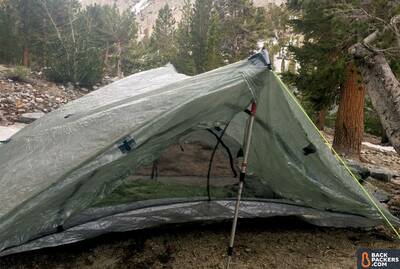
The Duplex is more than enough room for a single person. It does literally fit two, with a bit of room to spare.
The Duplex is gigantic! Plenty of room for one person to stretch out and keep all your gear inside the tent — and that’s not even counting the vestibules! Absolutely big enough for two people to get comfy, which is way more than most high-end “2P” tents can say.
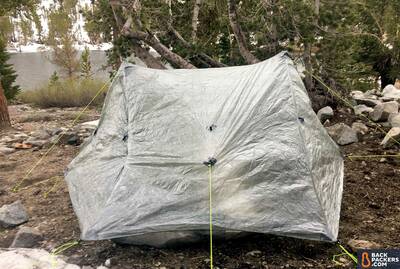
The vestibules aren’t fully staked out here, and still have plenty of room.
Digging Deeper
As I poked my way around the tent, I kept raising my eyebrows and nodding my head in appreciation. All of the small drawbacks of the Hexamid Solo had been addressed, and with authority!
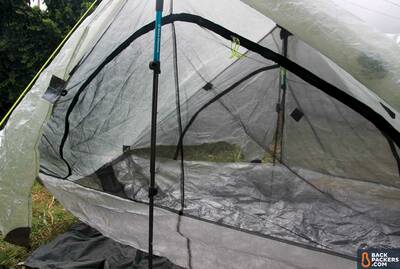
The bathtub floor of the Duplex is sewn right in, which means you’ll always have a clean and water resistant surface to sleep on.
The Duplex has a bathtub floor versus netting, which means rain protection and a true layer between you and the ground. It has gear pockets and large vestibules, making it an actual tent (versus a tarp-tent).
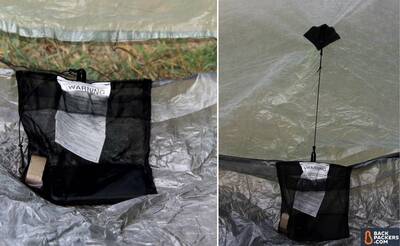
The two pockets on the Duplex are large enough for a headlamp or phone. They also are used to draw the ceiling closer to the floor, increasing protection against rain if necessary.
But by far and away the coolest feature is the zippered doors. This incredibly clever design (truly, the entire tent is a marvel of engineering) allows the shelter to be virtually wind and waterproof. This may not sound noteworthy if you are accustomed to traditional tents, but to be so light and packable AND offer full protection from the elements is spectacular.

Each door has two zippers, and the mesh opens fully for easy entry and exit. Paired with the vestibule doors (that roll up and out of the way if you want), this tent offers serious protection.
Sleep Comfort
I always sleep well in the backcountry. Falling asleep to running water and the soft rustling night sounds of the forest just does a body (well, my body) good. But I slept particularly well in the Duplex.
With enough room to move around freely, and complete protection from rain, wind, and bugs (oh yeah, the whole tent is protected by netting), I was able to let my guard down completely and just…sleep.
Durability
Amazing. Astonishing. Stupefying (OK, the thesaurus might have given me this one). The Duplex is made with Dyneema Composite Fabric (formerly called cuben fiber) that is so light and thin I expect it to rip like paper. But man can this thing take a beating!
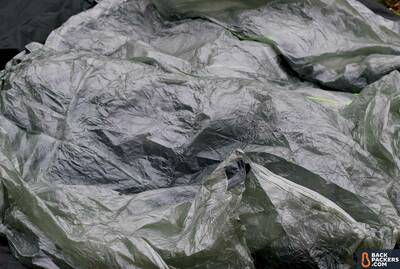
Dyneema Composite Fabric (DFC) is strange to the touch, almost papery, but it holds up over time like nothing else. The Duplex is almost entirely made of DFC.
Between the Hexamid Solo (same material) and the Duplex I have been on over twenty backcountry trips and set the tent up another fifty times for various presentations, without any indication of wear. No rips, no holes. The one thing that does occasionally happen is guy lines will come off or untie themselves, but that’s a very easy fix.
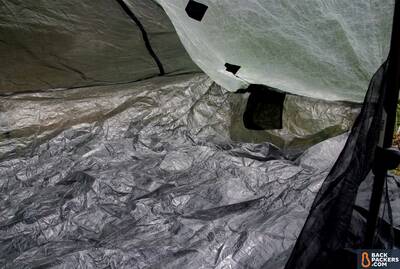
You can see the Duplex is made almost entirely of DFC fabric. The black mesh in the right-hand of this photo is the only other material used.
Ease of Setup
Pretty darn easy after you know what you’re doing. You’ll want to watch a setup video before venturing into the middle of nowhere though.
You will need hiking poles in order to give the tent tension (or you can buy carbon fiber tent poles from Zpacks), so be prepared for that, as it doesn’t come with them normally.
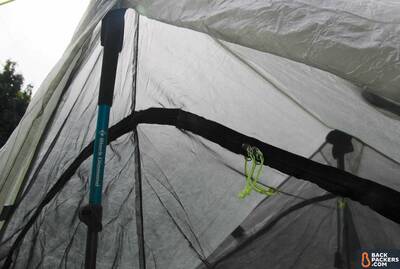
The Duplex doesn’t come with poles, and expects you to use trekking poles for setup. They need to be 48 inches in height, and they slide right into reinforced areas of the tent. First you have to stake out the tent, then insert the poles.
You’ll also need a large enough dirt area to sink your tent stakes in, as the tent must be staked out to stand up. The area for this is pretty large, so make sure you have enough room.
As long as you meet those requirements you’re good to go!
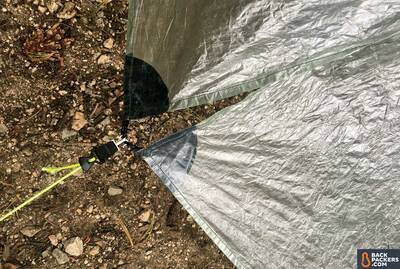
The Duplex has smartly designed the vestibule doors to be fully weatherproof when necessary, attaching via clip at the base.
Space
As mentioned above, I was blown away by how big the Duplex is. It’s not known for that, so maybe my expectations were just too low, but I felt like it was more than enough room for one person and definitely big enough for two, which is saying a lot for an ultralight backpacking tent.
Heck, bring your dog.
Vibe
Perfect. I want my backcountry shelter to be a sanctuary. All day I have maintained a certain vigilance that is necessary in the wild, so when it’s time to rest I want to be able to relax completely. Granted, this is mostly illusion — if a bear wants to make you his dinner a millimeter thick swath of Dyneema fabric won’t even slow him down — but it’s an illusion that matters.
The Zpacks Duplex creates this protected feeling wonderfully, and offers enough room that it can be a comfortable spot to hang out if the weather turns nasty. Or if you just want to spend a lazy afternoon in a blissful, half-asleep nap.
Grievances
While the Zpacks Duplex deserves a laundry list of accolades, simplicity is not necessarily one of them.
While it is easy to set up, it’s not the freestanding two-pole pop up design that has become so common with tent manufacturers. Practice setting it up in your backyard first.
I also don’t love the fact that I have to bring hiking poles (which I don’t generally use) just to get the tent to stand up. In the future I will just spring for the carbon fiber tent poles offered by Zpacks and pack those with the tent. Yeah, it increases the weight by five ounces (bringing the total weight to 26 ounces), but they’re lighter than most trekking poles you’d have to use. The carbon fiber poles do cost an extra $29 each, so be prepared for that cost (which is less money than most trekking poles if you don’t have them already).
Finally, internalize the fact that this tent is not freestanding, meaning it needs tent stakes to create tension and give it body. That means camping on large, generally flat, dirt-filled campgrounds are best. If you want to camp on hard rock where tent stakes won’t work, you’ll have to get creative with rocks or trees as your points of tension.
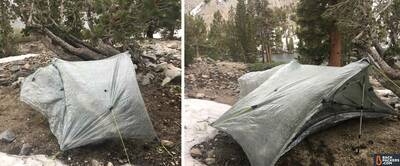
Staking out the Duplex is necessary, and requires some effort compared to traditional tents. Be prepared for this, and learn how to pitch the tent before you get to camp at night, hungry and in need of sleep.
Final Word
The Zpacks Duplex is a masterpiece of design and ingenuity. An ultralight backpacker simply will not find a tent that is lighter, roomier, more durable, or more packable. Standing ovation for Zpacks.
WWhere to Buy Zpacks Duplex
The Zpacks Duplex tent we tested is the standard version, which costs $599 retail, comes in olive, and does not come with any poles or tent stakes. Zpacks is a cottage gear company that offers a lot of customization to its products, so you can email them to get more specific or unique tent specifications.
One of their other standard Duplex offerings is the Camo DFC version, which is camo in color/pattern and uses .67 oz/sqyd instead of the .51 oz/sqyd of the tent we tested. They also offer a Spruce Green DFC version, which uses .74 oz/sqyd of DFC fabric.
Finally, you can purchase Straight Tent Poles instead of using your own trekking poles, or you can buy the Duplex Flex Tent Upgrade, which makes the tent freestanding. Zpacks also sells Ultralight Stakes, or you can use stakes from any other manufacturer. You need eight stakes to set up the tent properly, unless you have the freestanding upgrade, in which case you need two stakes to set up the vestibules.
Zpacks tents are only sold by Zpacks.
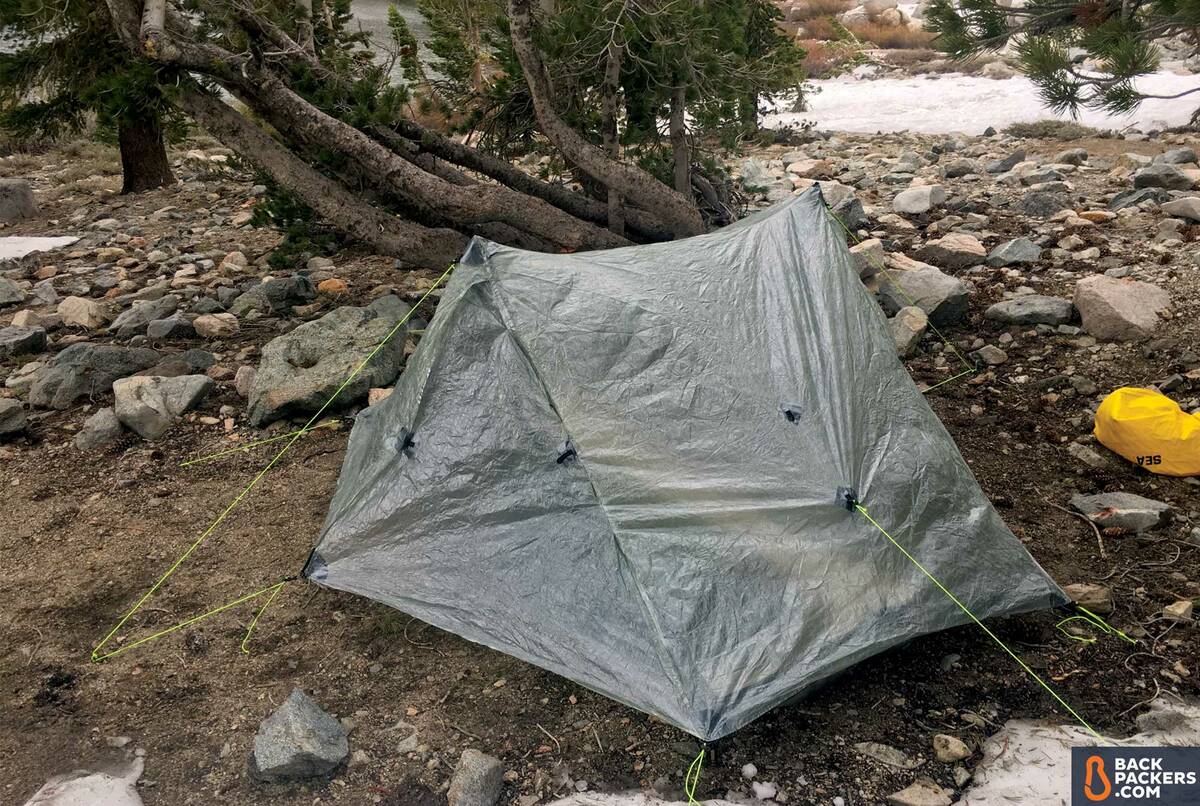




The Duplex is great except when you wait weeks and then get one that is incomplete – the loop to hold back the door was missing. I emailed them and waited for days, emailed again, and finally got a response. They offered to send me a stick-on patch! Yep, a $600 tent with a stick-on patch. Or I can send it back. Pay postage, wait for weeks again. I would like to use this tent, but I don’t trust them.
Sorry to hear about your experience with Zpacks, Cindy. We’ve had great communication with the brand, both as customers and as media.
Have you reached out to them to more fully illustrate your issue? Small companies like Zpacks tend to take customer service very seriously.
I through hiked the Appalachian Trail in 2019. I had purchased the Z-Paks duplex tent thinking it was the tent for me. After a month of using it on the trail I sent it home and had my friend send me my Big Agnes Copper Spur 2. I am 6.5, what I found because of my height my feet would hit the end of the tent and when it was raining water would penetrate inside. On Zpacks website they offer suggestions on setting up your tent to curb the water and condensation issues. However when you’re hiking the Appalachian Trail setting up your tent can’t airways be in ideal conditions. At one point I was brushing off ice on the inside top of my tent because of the frozen condensation.
Some of the other through hiker‘s loved the tent. I wasn’t pleased at all.
PRO’S
Light weight
Easy to set up
CON’S
Over priced.
To long for the order to arrive.
Condensation issues.
Water penetration issues. (If you’re tall this tent Is not for you).
All Communication have to be done via email.
Summary:
Overall when I reached out to a Zpack asking for help on the issues I was experiencing I was told to sleep at a angle and to refer to their helpful hints on their website. In reality the tips on their website were for ideal situations that are seldom going to exist when you’re hiking. I overall feel that their customer service is poor. You think It would be top-of-the-line with the prices they are charging for their tents. If you’re not tall and you don’t mind the condensation problems. This might be the tent for you.
Hi Mayor,
Thanks for such a detailed review of the Zpacks Duplex. The BA Copper Spur and Zpacks Duplex are pretty different tents, from construction to setup method to number of features. Some folks tend to love the more minimalist approach. Thanks for the valid feedback.